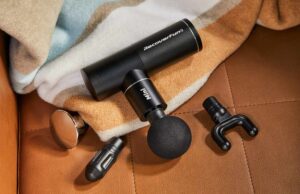
The only clinical situation that requires a short latency in the onset of muscle relaxation is rapid induction on a full stomach. In the rest of the cases, the time of commencement of action of the MR is a secondary factor. All anaesthesia in an elective situation can be induced with non-depolarizing blockers regardless of their latency, both for intubation and maintaining relaxation.
D-tubocurarine:
It is the classic example of competitive antagonists at the neuromuscular junction. It is a benzylisoquinoline. Blockade of cholinergic receptors is nonselective at the neuromuscular junction, and blockade of sympathetic autonomic ganglia produces hypotension. May release histamine at commonly used doses. Produces sympathetic block. The appearance of drugs that do not have these side effects has limited the use of d-Tubocurarine to pre-curarization to reduce the incidence of fasciculations and myalgias caused by succinylcholine by 30%. The precurarization dose is 0.07 mg/kg. Latency time: 3-5 minutes. It produces a profound neuromuscular blockade at a dose of 0.3 mg/kg, lasting 70 – 90 minutes.
Atracurium:
Atracurium besylate is a benzylisoquinoline-type muscle relaxant with an intermediate duration of action. Atracurium undergoes extensive metabolism following intravenous injection, with less than ten per cent excreted unchanged in the urine. Atracurium is metabolised by two mechanisms: Hoffman elimination and ester hydrolysis, with laudanosine metabolites of both reactions. The Hoffman elimination is a spontaneous, non-enzymatic degradation at physiological temperature and pH, occurring at the quaternary nitrogen on the aliphatic side of the atracurium and cis-atracurium molecule. Ester hydrolysis is mediated by nonspecific esterases unrelated to plasma cholinesterase. Both pathways for elimination are independent of renal and hepatic function, which allows its use in patients with impaired function of these organs. Atracurium is associated with adverse reactions in 0.01-0.02% of patients; most are due to histamine release. Adverse effects include anaphylaxis, hypotension (2%), vasodilatation, flushing (5%), tachycardia (2%), dyspnea, bronchospasm (0.2%), laryngospasm, rash, and urticaria (0.1%). Laudanosine, excreted by the kidneys, causes convulsions at high concentrations; For this reason, long-term infusions should be avoided in patients with kidney disease. Its short duration, and lack of cardiovascular side effects make atracurium a suitable drug for patients with renal and hepatic failure, cardiovascular disease, and ambulatory surgery. Dosage: 0.3 -0.6mg/kg. Duration of action: 30 minutes. Supplementary doses: 5 to 10 mg. Infusion dose: 5-10 µg/kg/min. 50mg ampoules.
Cis-atracurium:
Cis-atracurium is one of the isomers of atracurium. It belongs to the benzylisoquinolines. It produces less histamine release than atracurium, thus causing fewer hemodynamic side effects at high doses. It is more potent and has a slightly longer duration of action than atracurium. Cisatracurium is metabolized in plasma by the Hoffman pathway, independent of hepatic and renal function. The metabolic pathway mediated by plasma esterases has a limited role. The degradation half-life of cis-atracurium in plasma is 29 minutes. The terminal metabolites are laudanosine and alcohol, with no relaxing effect. Cisatracurium is 4 to 5 times more potent than atracurium. Used in infusion for 24 hours, the laudanosine concentration is 3 to 4 times lower than atracurium at equipotent doses. The elimination half-life is 22-25 minutes. At a DE95 amount, histamine release is much lower than atracurium. The recommended dose for intubation is 150mg/kg. This dose produces an initiation of relaxation similar to vecuronium and atracurium but of a longer duration. The curative maintenance dose can be in boluses of 30mg/kg approximately every 20 minutes or continuous infusion at 1.5mg/kg/minute. This dose produces an initiation of relaxation similar to vecuronium and atracurium but of a longer duration. The curative maintenance dose can be in boluses of 30mg/kg approximately every 20 minutes or continuous infusion at 1.5mg/kg/minute. This dose produces an initiation of relaxation similar to vecuronium and atracurium but of a longer duration. The curative maintenance dose can be in boluses of 30mg/kg approximately every 20 minutes or continuous infusion at 1.5mg/kg/minute.
Mivacurio:
is a benzylisoquinoline that has a short duration of action. It is metabolised by plasma cholinesterase. It is not associated with vagolytic activity or ganglionic blockade. Histamine release may occur, especially on rapid injection. Neostigmine speeds recovery from mivacurium curarization. Mivacurium produces histamine release, like atracurium. The 100 mg/kg bolus dose has a duration of 10 minutes. The recommended dose is 150 mg/kg. Doses of 200 mg/kg have 15-20 minutes. The latency time decreases by increasing the dose. Infusion: Mivacurium is the curare of choice in continuous injection as it has no cumulative effects. Doses for information are 6 – 8 mg/kg/minute with monitoring of curarization.
Rocuronium:
exerts its effect after 2 minutes; it is the fastest latency RMND. It is an intermediate-acting aminosteroid. It has minimal histamine release and cardiovascular effects; at high doses, it has moderate vagolytic activity. It is taken up by the liver to be eliminated by the bile without being metabolised. Less than 30% is found in the urine. The elimination half-life is 131 minutes. A metabolite of rocuronium, 17-diacetyl rocuronium, has rarely been found in plasma or urine after a dose of 0.5 mg/kg to 1.0 mg/kg, with or without subsequent infusion for up to 12 hours. This metabolite has a muscle blocking activity of approximately 1/20 that of rocuronium. A dose of 600 mg/kg allows for good intubation conditions in 60 – 90 s with a clinical duration of 30 minutes.
Mncaintenae:
Boluses of 1/4 of the initial dose (150 mg/kg). Infusion dose: 5 – 10 mg/kg/minute. Relaxation monitoring is essential.
Pancuronium is a long-acting, non-depolarizing aminosteroid muscle relaxant. It competes with acetylcholine for nicotinic receptors at the neuromuscular junction. It antagonises autonomic cholinergic receptors and causes stimulation of the sympathetic nervous system and selective cardiac vagal blockade. It produces a 10 to 15% elevation in heart rate, mean arterial pressure, and cardiac output. Does not release histamine. In patients with myocardial ischemia, tachycardia should be avoided. The long latency of 3-4 minutes limits its usefulness for endotracheal intubation. It is generally used for prolonged mechanical ventilation in intensive care units or long-term surgeries. Dosage: 0.1mg/kg. Intubation dose: 0.15 mg/kg. Duration: 40 – 60 minutes. Excretion is renal in 80% without changes in structure and biliary in 5-10% without changes. Degradation is by hepatic deacetylation in 10 to 40%. The elimination half-life is 2.4 hours.
Vecuronium:
Vecuronium is an intermediate-acting steroidal muscle relaxant derived from pancuronium. It does not produce histamine release and has no cardiovascular effects. Vecuronium has been proposed for curarization in severe renal failure due to its predominantly hepatic elimination. It is metabolised in the liver by deacetylation. Renal elimination has a less critical role. 20 to 30% is eliminated in the urine. The elimination half-life of vecuronium is 116 minutes, with a duration of action comparable to atracurium. It should be used in shock, coronary patients, arterial hypertension and allergic patients. In patients with liver failure and cholestasis, it should be used cautiously and always with monitoring. Histamine release is almost nil. At doses ten times higher than the curative ones, it does not have ganglioplegic effects. It has no sympathomimetic effects. Hemodynamic effects are discrete.
Cases of significant bradycardia have been described during induction, possibly due to high doses of opiates. Dosage: Adult: 0.07 – 0.1 mg/kg. It produces about 40 minutes.
Maintenance:
Boluses of 1/4 of the initial dose. Infusion: 1 – 2 mg/kg/minute. The use of curarization monitoring is recommended. Vecuronium is readily antagonised by neostigmine. It produces about 40 minutes. Maintenance: Boluses of 1/4 of the initial dose.
Infusion:
1 – 2 mg/kg/minute. The use of curarization monitoring is recommended. Vecuronium is readily antagonised by neostigmine. It produces about 40 minutes. Maintenance: Boluses of 1/4 of the initial dose. Infusion: 1 – 2 mg/kg/minute. The use of curarization monitoring is recommended. Vecuronium is readily antagonised by neostigmine.
Rapacuronium:
It is the only RMND(Relajantes Musculares No Despolarizantes) with a short latency time and a brief to the intermediate duration of action. Its latency time is very similar to that of succinylcholine, and the period of activity is comparable to that of mivacurium. Adverse reactions are bronchospasm in adults, tachycardia in children, and hypotension in the elderly. It can be reversed early from a deep block, which gives it a clinical duration similar to that of succinylcholine. Although it has been designed to replace succinylcholine, it is not a problem to use it as a single agent with repeated doses, considering that it transforms into a relaxant with a spectrum of intermediate duration.
The recommended intubation dose is 1.5 mg/kg. The latency time is 55 to 70 s. Spontaneous recovery with T1 25% (First contraction: 25% of control) is 14 min and the interval T1 25% – TDC = 0.8 takes 19 min. If shorter recovery times are required, it should be reversed with anticholinesterase agents.







